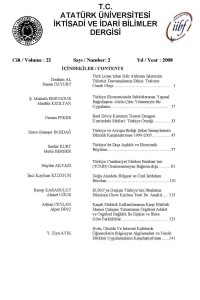EVDE, OKULDA VE İNTERNET KAFELERDE ÖĞRENCİLERİN BİLGİSAYAR ALGILAMALARI VE TERCİH ETTİKLERİ UYGULAMALARIN KARŞILAŞTIRILMASI
Öz
Bu çalışmada, evde, okulda ve İnternet kafelerde öğrencilerin
bilgisayar algılamaları ve tercih ettikleri bilgisayar uygulamaları incelenmiştir.
Bu amaçla söz konusu üç çevrede öğrencilerin bilgisayar kullanım sıklıkları ve
bilgisayar kullanırken yaptıkları uygulamalar ile yapmak istedikleri uygulamalar
araştırılmış ve aradaki farklar ortaya koyulmaya çalışılmıştır. Araştırma
Erzurum ilinde bulunan ikisi özel olmak üzere 6 ilköğretim okulunda 6. 7. ve 8.
sınıf öğrencileri üzerinde yapılmıştır. Okullar sosyal statü olarak farklı
çevrelerden, anket uygulanan öğrenciler ise bu okullardaki sınıflardan rastgele
seçilmişlerdir. Veriler SPSS 11.5 istatistik paket programıyla değerlendirilmiş,χ2
ve student t testinin yanı sıra % değerler de belirlenmiştir. Araştırma
sonucunda, öğrencilerin evde, okulda ve internet kafelerde bilgisayar kullanım
sıklıkları ve uygulamaları arasında önemli farklar olduğu tespit edilmiştir.
Anahtar Kelimeler
Kaynakça
- Attewell, P. & Battle, J. (1998), Home computers and school performance. Information Society, 15,(1), ss.1-10.
- Campbell, K. (2000), Gender nd educational technologies: Relational frameworks for learning design. Journal of Educational Multimedia and Hypermedia, 9(1), ss.131-149.
- Colley, A.M., Gale, M.T. and Harris, T.A. (1994), Effects of gender role identity and experience on computer attitude components. Journal of Educational Computing Research 10 2, ss.129–137.
- Downes, T. (1996), The computer as a toy and tool in the home: implications for schools and teachers. Education and Information Technologies 1, ss.191–201.
- Jackson, A., Fletcher, B. and Messer, D. (1988), Effects of experience on microcomputer use in primary schools: results of a second survey. Journal of Computer Assisted Learning 4, ss.214–226.
- Kirkman, C. (1993), Computer experience and attitudes of 12-year old students: Implications for the UK National Curriculum. Journal of Computer Assisted Learning, 7. ss.187-194.
- Kirkman, C. (1993), Computer experience and attitudes of 12-year-old students: implications for the UK national curriculum. Journal of Computer Assisted Learning 9, ss.51-62.
- Mohamedali, M.H., Messer, D.J., ve Fletcher, B. (1987). Factors affecting microcomputer use and programming ability of secondary school children. Journal of computer assisted learning 3,ss.224-239.
- Mumtaz, S. (2001), Children’s enjoyment and perception of computer use in the home and the school. Computers & Education 36, ss.347-362.
- Obut, F. ve diğerleri, 1997. Bilgisayar ve Orta Öğretim Okullarında Bilgisayar Destekli Eğitim. Http://www.odevsel.com
- Ofsted, (1998), A review of primary schools in England, (1994–1998). Available at http://www.official-documents.co.uk/documents/ofsted/ped/ped.htm (last viewed January 2000). The Stationery Office.
- Osin, L., Nesher, P. ve Ram, J. (1994), Do the rich become richer and the poor poorer? A longitudinal analysis of pupil achievement and progress in elementary schools using computer-assisted instruction. International Journal of Educational Journal, 21(1), ss.53-64.
- Selwyn, N. (1997), The effect of using a computer at home on students' school use of IT. Research in Education 58, ss.79–81
- Selwyn, N. (1998), The effect of using a home computer on students’ educational use of IT. Computers & Education 31, ss.211-227.
- Shoffner, L.B. (1990), The effects of home environment on achievement and attitudes towards computer literacy. Educational Research Quarterly 14 1, ss.6–14
- Underwood, J. and Underwood, G. (1990), Computers and learning: Helping children acquire thinking skills. , Blackwell, Oxford, ss.132-134
- Underwood, J., Billingham, M. and Underwood, G. (1994), Predicting computer literacy: how do the technological experiences of schoolchildren predict their computer-based problem-solving skills?. Journal of Information Technology for Teacher Education 3, ss. 115–126.
Öz
Kaynakça
- Attewell, P. & Battle, J. (1998), Home computers and school performance. Information Society, 15,(1), ss.1-10.
- Campbell, K. (2000), Gender nd educational technologies: Relational frameworks for learning design. Journal of Educational Multimedia and Hypermedia, 9(1), ss.131-149.
- Colley, A.M., Gale, M.T. and Harris, T.A. (1994), Effects of gender role identity and experience on computer attitude components. Journal of Educational Computing Research 10 2, ss.129–137.
- Downes, T. (1996), The computer as a toy and tool in the home: implications for schools and teachers. Education and Information Technologies 1, ss.191–201.
- Jackson, A., Fletcher, B. and Messer, D. (1988), Effects of experience on microcomputer use in primary schools: results of a second survey. Journal of Computer Assisted Learning 4, ss.214–226.
- Kirkman, C. (1993), Computer experience and attitudes of 12-year old students: Implications for the UK National Curriculum. Journal of Computer Assisted Learning, 7. ss.187-194.
- Kirkman, C. (1993), Computer experience and attitudes of 12-year-old students: implications for the UK national curriculum. Journal of Computer Assisted Learning 9, ss.51-62.
- Mohamedali, M.H., Messer, D.J., ve Fletcher, B. (1987). Factors affecting microcomputer use and programming ability of secondary school children. Journal of computer assisted learning 3,ss.224-239.
- Mumtaz, S. (2001), Children’s enjoyment and perception of computer use in the home and the school. Computers & Education 36, ss.347-362.
- Obut, F. ve diğerleri, 1997. Bilgisayar ve Orta Öğretim Okullarında Bilgisayar Destekli Eğitim. Http://www.odevsel.com
- Ofsted, (1998), A review of primary schools in England, (1994–1998). Available at http://www.official-documents.co.uk/documents/ofsted/ped/ped.htm (last viewed January 2000). The Stationery Office.
- Osin, L., Nesher, P. ve Ram, J. (1994), Do the rich become richer and the poor poorer? A longitudinal analysis of pupil achievement and progress in elementary schools using computer-assisted instruction. International Journal of Educational Journal, 21(1), ss.53-64.
- Selwyn, N. (1997), The effect of using a computer at home on students' school use of IT. Research in Education 58, ss.79–81
- Selwyn, N. (1998), The effect of using a home computer on students’ educational use of IT. Computers & Education 31, ss.211-227.
- Shoffner, L.B. (1990), The effects of home environment on achievement and attitudes towards computer literacy. Educational Research Quarterly 14 1, ss.6–14
- Underwood, J. and Underwood, G. (1990), Computers and learning: Helping children acquire thinking skills. , Blackwell, Oxford, ss.132-134
- Underwood, J., Billingham, M. and Underwood, G. (1994), Predicting computer literacy: how do the technological experiences of schoolchildren predict their computer-based problem-solving skills?. Journal of Information Technology for Teacher Education 3, ss. 115–126.
Ayrıntılar
| Birincil Dil | tr;en |
|---|---|
| Bölüm | Makaleler |
| Yazarlar | |
| Yayımlanma Tarihi | 27 Kasım 2010 |
| Yayımlandığı Sayı | Yıl 2008 Cilt: 22 Sayı: 2 |





